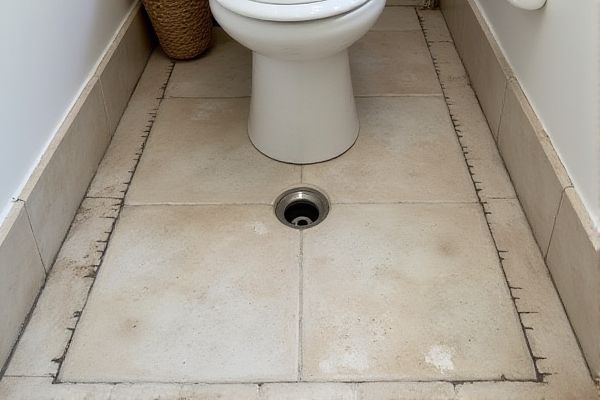
A tile-in drain integrates seamlessly with tiled surfaces, offering a sleek, flush finish that enhances bathroom aesthetics and improves water drainage efficiency compared to a standard drain, which typically protrudes and can disrupt tile patterns. Discover which drain type suits Your renovation needs and ensures optimal functionality by reading the rest of the article.
Table of Comparison
| Feature | Tile-In Drain | Standard Drain |
|---|---|---|
| Design | Integrated into tile surface for seamless look | Standalone drain installed separately |
| Installation | Requires precise tile layout and waterproofing | Simple installation, flexible placement |
| Water Drainage | Efficient, directs water through tile surface | Standard water flow, may require slope adjustments |
| Maintenance | Easy to clean, low visibility dirt build-up | Accessible but visible; may trap debris |
| Aesthetic | Modern, minimalistic, blends with flooring | Traditional, visible metal or plastic cover |
| Cost | Higher upfront cost due to design and installation | Lower initial cost and simpler repairs |
Introduction to Tile-in Drains and Standard Drains
Tile-in drains integrate seamlessly with tile flooring, offering a discreet and efficient water drainage solution ideal for showers and wet areas. Standard drains, typically made from metal or plastic, are surface-mounted and easier to install but may interrupt the visual continuity of tiled surfaces. Both types efficiently remove water, but tile-in drains provide enhanced aesthetics and a flush, streamlined finish compared to the raised profile of standard drains.
What is a Tile-in Drain?
A Tile-in drain is a type of drainage system designed to be integrated directly into the flooring or shower base, offering a sleek and seamless water outlet option. Unlike standard drains, which typically sit above the floor surface, tile-in drains are covered with matching tiles, enhancing aesthetic appeal while maintaining effective water drainage. This design not only prevents water pooling but also creates a minimalist look, ideal for modern bathroom renovations.
What is a Standard Drain?
A standard drain is a basic drainage system designed to collect and channel surface water away from areas such as foundations, driveways, and landscaping to prevent flooding and water damage. Typically made of perforated pipes surrounded by gravel and fabric, it allows water to seep through the soil and enter the pipe for efficient drainage. Understanding how a standard drain functions helps you choose the right system for managing water runoff in your property.
Aesthetic Differences Between Tile-in and Standard Drains
Tile-in drains seamlessly blend with flooring by allowing tiles to be embedded directly into the drain cover, creating a uniform and minimalistic appearance. Standard drains feature pre-designed grates that often contrast with surrounding materials, making them more visually prominent in bathroom or shower floors. The tile-in option enhances overall design cohesion, ideal for modern and high-end installations seeking subtle and custom aesthetics.
Installation Process: Tile-in vs Standard Drain
The installation process for tile-in drains involves setting the drain grate flush with surrounding tiles, requiring precise leveling and waterproofing to ensure seamless integration with the tiled surface. Standard drains are typically installed with a pre-fabricated grate that sits above the floor surface, allowing for quicker installation but less customization in appearance. Tile-in drains demand meticulous planning and skilled labor to achieve a flush, aesthetically pleasing finish, while standard drains offer more straightforward, time-efficient installation with lower complexity.
Maintenance and Cleaning Considerations
Tile-in drains feature removable grates that simplify access for routine cleaning, preventing debris buildup and reducing the risk of clogs in your drainage system. In contrast, standard drains often require more effort to remove covers or clear blockages, potentially leading to more frequent professional maintenance. Choosing a tile-in drain can enhance ease of maintenance and prolong the lifespan of your drainage system by facilitating quicker, more efficient cleaning.
Cost Comparison: Tile-in vs Standard Drains
Tile-in drains typically incur higher installation costs due to their integrated design that requires precise tile alignment and waterproofing, increasing labor expenses. Standard drains are generally more affordable, featuring simpler installation processes and less material complexity, making them a cost-effective choice for many projects. Your decision should weigh initial investment against aesthetics and long-term maintenance, as tile-in drains offer a seamless look but may demand higher upfront costs.
Water Drainage Efficiency
Tile-in drains offer superior water drainage efficiency compared to standard drains by incorporating a larger surface area and integrated grating that directs water quickly and uniformly into the drainage system. Their design minimizes water accumulation and reduces the risk of clogging, ensuring consistent and effective water flow. Standard drains, often limited by smaller openings and basic grates, can struggle with heavy water volumes leading to slower drainage and potential pooling.
Durability and Lifespan
Tile-in drains feature a durable design that integrates seamlessly with flooring materials, providing enhanced protection against water damage and reducing wear over time. Standard drains, typically made from less robust materials, may be more prone to corrosion and require more frequent maintenance or replacement. Choosing a tile-in drain can extend the lifespan of your drainage system by ensuring a longer-lasting, structurally sound solution.
Which Drain is Right for Your Bathroom?
Tile-in drains offer a seamless, customizable look by allowing bathroom tiles to blend directly into the drain cover, enhancing aesthetic appeal and preventing water pooling. Standard drains provide a more conventional and cost-effective solution, typically easier to install and compatible with most bathroom designs. Choosing the right drain depends on your bathroom's style, budget, and preference for either a sleek, integrated finish or a straightforward, practical option.
 homyna.com
homyna.com